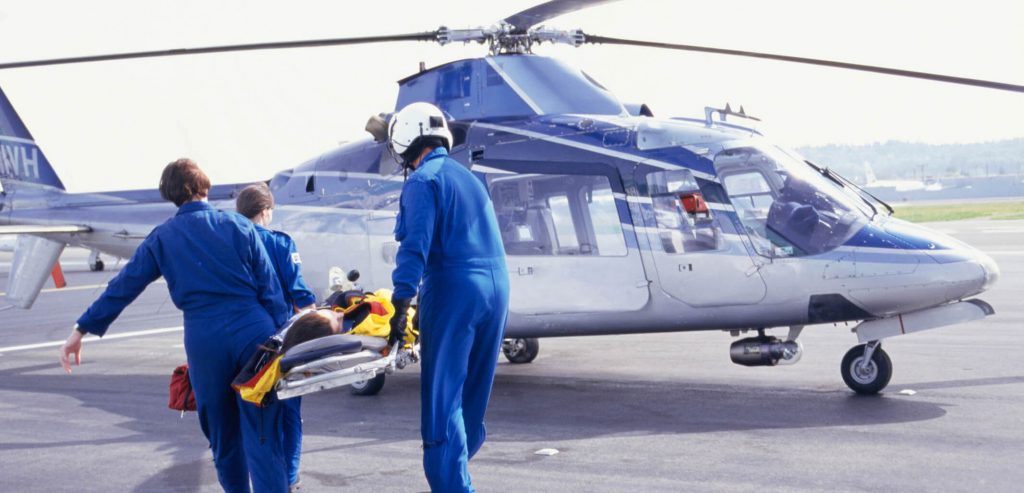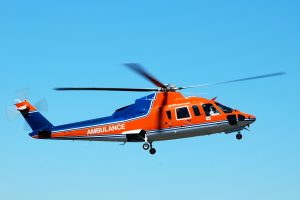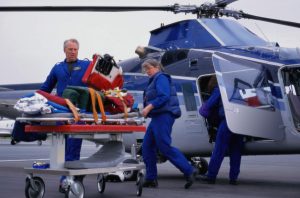
Flight nurses share a serious responsibility to provide critical care for patients while they are being transported to a hospital, this role is not for the faint of heart, but rather someone who is an expert nurse with a true passion for saving lives, who possess the ability to deliver care in extreme scenarios every shift.

Have you ever wondered what it takes to be a flight nurse? Flight nurses, also known as aircraft–, helicopter–, or transport nurses, are highly-skilled medical professionals who provide lifesaving medical care in the air, often in extreme and stressful conditions. As a transport nurse, you’ll have the opportunity to make a difference in people’s lives while working with an expert team of fellow healthcare professionals.
It takes stamina, dedication, and specialized training to excel as a flight nurse, but if you’re looking for an adrenaline rush coupled with job satisfaction then this career could definitely be for you! In this article, we provide all the information you need to know to become a successful transport nurse, including the qualifications needed, skills required, and the current job market, with flight nurse salaries and career projections.

A flight nurse is an advanced healthcare professional responsible for the medical care of patients prior to and while being transported by airplane or helicopter. They are registered nurses (RNs) who have specialized training in critical care , trauma , and emergency management . Aircraft nurses possess invaluable skills that make them critical members of the aeromedical transport team. These nurses also have training in aviation and aviation safety.
Transport nurses will have the option to choose to practice as civilian flight nurses or as military flight nurses. Both share many responsibilities but differ dramatically in some ways, as we will highlight below.
Flight nursing goes beyond the duties of a traditional nursing role. In-flight nurses are part of a healthcare team that usually includes flight physicians and paramedics. These nurses are responsible for meticulous pre-hospital, emergency care while in transit to a healthcare facility. This emergency care encompasses nearly all patient populations. In addition, the duties of a transport nurse include a wide range of responsibilities, like in-flight monitoring of patient vitals, record keeping, medication administration, or executing a range of medical procedures, including life-saving interventions that require immediate attention – to name a few.
Transport nurses must remain ready until their services are needed, much like the typical ambulatory services of an emergency medical technician (EMT) crew.
They play an imperative role in patient care and status by staying connected with the ground crews. Maintaining ongoing communication, they ensure that patients can be transferred to their respective medical facilities quickly upon landing.
A transport nurse will basically perform all the duties of an ER or ICU nurse, however, with an added element of time-sensitive and urgent conditions, coupled with air travel, confined quarters, and limited resources.
A civilian flight nurse will typically deal with situations that involve transporting newborn babies to a different hospital, moving patients from emergency situations (like a car accident) to a hospital, transferring ill patients to a new location, organ donation, and more.
Military flight nursing is a specialized role that requires the enlistment of Air Force nurses to provide comprehensive care for military members during their transport from one destination to another. This could be anything from evacuating them away from a war zone and into medical safety, relocating them somewhere more appropriate with access to treatments, or even something as simple as transferring them back home. The work of these brave nurses should always be respected and admired, for caring for those wounded in battle is unlike any other task a civilian flight nurse will encounter.

While ZipRecruiter is seeing annual salaries as high as $120,000 and as low as $59,500, the majority of Flight Nurse salaries currently range between $65,000 (25th percentile) to $102,000 (75th percentile), with top earners (90th percentile) making $109,000 annually across the United States. The average pay range for a Transport Nurse varies significantly by as much as $37,000, suggesting there may be many opportunities for advancement and increased pay based on skill level, location, and years of experience.

You must obtain an RN licensure to practice as a transport nurse. You can earn your RN license by graduating with an associate (ADN) or bachelor’s degree in nursing ( BSN ) from an accredited nursing program and passing the NCLEX-RN exam. Many flight nurses chose to continue their education by earning an MSN . This extra knowledge and training could elevate your job opportunities, earnings, and professional expertise.
For Registered Nurses wishing to pursue flight nursing, it is recommended you first develop expertise in the Emergency Room or Intensive Care Unit before venturing into transport nurse roles. This critical care experience will prove invaluable and increase your chances of becoming a successful flight nurse. Usually, employers seek 3-5 years of experience in the ICU/ER before seriously considering a candidate.
Aspiring flight nurses should also have a foundational understanding of navigation and flying.
You will need to maintain your RN state licensure, first and foremost. To increase your employment chances, as well as to advance your career and provide the highest quality of patient care, employers suggest obtaining the Certified Flight Registered Nurse certification (CFRN) from the Board of Certification for Emergency Nursing (BCEN).
Aside from that principal certification, a flight nurse is usually required to possess these certifications, too:
The Air and Surface Transport Nurses Association (ASTNA) also offers certification programs for registered nurses, such as the Pediatric Advanced Transport course (PATC).
Flight nursing is a highly demanding job requiring strong interpersonal skills, including communication with other healthcare team members and family members. You will also need to acquire the expertise necessary to assess and treat medical and environmental conditions encountered during flight. This critical role helps to maintain patient safety throughout transport.